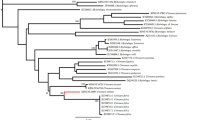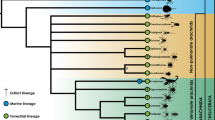Abstract
ONE of the difficulties in an account of the origin of the echinoderms is their five-fold radial symmetry. Nichols1 has proposed a hypothetical ancestral echinoderm derived from a lophophorate ancestor. Sipunculoids have a recurved gut and a hydraulically operated tentacular system using a special compartment of the coelom. These resemblances to echinoderms suggest that a sipunculoid-like animal might have given rise to an ancestor of the echinoderms by developing a calcite skeleton for protection. This ancestor is illustrated in cross section in Fig. 1, but Nichols was unable to say why it should be pentamerous. On analysis of the requirements of such an animal, however, it has been possible to produce a ‘paradigm’ (in Rudwick's sense2) which demands five rays.
Similar content being viewed by others
References
Nichols, D., in Symp. zool Soc. Lond. (edit. by Millott, N.), 20, 209–229 (Academic, London and New York, 1967).
Rudwick, M. J. S., Br. J. phil. Sci., 15, 27–40 (1964).
Bather, F. A., in A Treatise on Zoology, Part III (edit. by Lankester, E. R.), 11 (Black, London, 1900).
Hyman, L. H., The Invertebrates, 5, Lesser Coelomate hyla (McGraw-Hill, 1959).
Author information
Authors and Affiliations
Rights and permissions
About this article
Cite this article
STEPHENSON, D. Pentamerism and the ancestral echinoderm. Nature 250, 82–83 (1974). https://doi.org/10.1038/250082a0
Received:
Published:
Issue Date:
DOI: https://doi.org/10.1038/250082a0
- Springer Nature Limited
This article is cited by
-
A fossil crinoid with four arms, Mississippian (Lower Carboniferous) of Clitheroe, Lancashire, UK
Swiss Journal of Palaeontology (2018)





